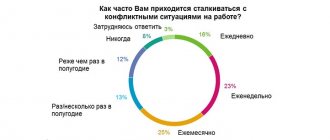Sooner or later there will be an explosion: no one can live without conflicts. One common form is when a person disagrees with a group. But if squabbles get out of hand, cohesion and, at some point, success will be at stake. Conflict resolution techniques are needed. How can you learn to find compromises with a company? What are conflict resolution strategies?
In this article:
Why resolve conflicts with a group? Conflict resolution strategies and their assessment Different types of conflicts How to recognize conflicts in a group Reducing the likelihood of conflict: 4 important factors 8 questions about conflict resolution
Why resolve conflicts with the group?
Photo by Angela Roma: Pexels
It’s cruel but true: in this world, conflicts are more normal than exceptional. For example, in the workplace. Harmony and harp sounds? Rarely seen. The good news is that many conflicts disappear on their own.
It is not necessary to settle every dispute by turning to a mediator. Other conflicts flare up regularly - or swing so high that an explanatory conversation over tea and cookies is no longer enough to resolve them. However, resolving disagreements is important for the health of the participants and the success of the entire group.
Is it a destructive conflict? Which
Conflict is a contradiction of interests and views of individuals or groups. Psychologists. individuals are encouraged to learn how to manage conflict. In this case, all parties will be able to express their vision and come to a consensus.
Destructive behavior is characterized by the inability to adequately perceive the opinions of others.
In this case, there are two options for managing Destructive:
- confrontation - the individual deliberately aggravates the conflict, insults the individual, is overly emotional, provokes aggression towards the opponent, thereby aggravating the situation.
- In this case, in the Conformist case, a person submits to his opponent without reservations, even if he does not agree with him.
Conflict resolution strategies and their assessment
Dispute mediation is the best form of conflict resolution. But there are different, more or less reasonable, conflict resolution strategies:
The escape
Those who run away follow an avoidance strategy. This can be useful when the enemy is much stronger. At the same time, this is not a real solution to the conflict, because the “refugee” has no room for maneuver.
Struggle
He who fights can win an argument or discussion. However, this is not always satisfactory—the law of the strong does not necessarily lead to the best solutions. But this is especially important when it comes to collaboration.
5 Ways to Resolve Conflict
Resignation
The other side of the coin is to give up early. So, you have peace of mind, but again you cannot voice your ideas and desires. Thus, resignation is not suitable as a permanent conflict resolution strategy.
Mediation
If the battles are completely bitter, a neutral perspective can help resolve the conflict. This can be done through mediation or observation.
Compromise
To compromise, the conflicting parties need significantly greater tolerance. This is only a partial agreement, as the parties are giving up some aspects. Moreover, the cause of the conflict has not been fully resolved. So this is also not an ideal option.
Agreement
Agreement or cooperation can be reached if both parties to the conflict find common solutions. The point is not to unilaterally force something, but to develop a constructive solution to the conflict.
Behavior in a conflict situation
Our behavior in personal relationships also varies depending on who we are in contact with: for example, the model of behavior in the family circle and in the work team will be different. The question arises, how many roles can one person simultaneously perform?
Not everyone is capable of engaging in self-observation and analyzing their actions, the feelings they experience, and predicting the reactions of those around them. However, there are those who constantly think about the consequences and predict possible reactions. And so the second type more often chooses a model of behavior that it considers more acceptable to others, that is, it adapts to them.
Photo: Pexels.com
Different types of conflicts
There are different types of conflicts. These are, for example, value conflicts, power conflicts, goal conflicts, relationship conflicts or perception conflicts. The causes of the conflict may be specific:
- Personal animosity.
- Different values (politics, religion, society, etc.).
- Envy and jealousy among colleagues.
- Tension due to increasing pressure from competitors.
- Mobbing.
Giphy
- Weak leadership.
- Stress and excessive demands.
- Fuzzy assignments and task distribution.
- Health problems.
Knowing these types of conflicts can be a step towards resolving them. Because a vigilant observer can recognize a problem through certain premises.
Types of contradictions
- Internal contradictions are a clash of interests of two parties, represented by individuals, groups or organizations.
- Antagonistic - open hostility that does not imply a truce; non-antagonistic – accepting compromises).
- Basic and non-basic contradictions;
- Objective and subjective contradictions.
At the beginning of any kind of conflict there are contradictions that manifest themselves in social tension; they are latent and static; conflict is an open form of conflict.
Social conflict is a stage of clash of interests of individuals, groups, institutions or organizations that increase opposing tendencies. It is expressed in the confrontation of individuals or groups for the use or possession of a good.
How to recognize conflicts in a group
Resolving conflict is not always easy. But first you need to recognize it as such. This is not always so simple, especially in large, extensive companies and groups. Signs of impending conflict may include (for example, at work):
- The number of reports of illness is increasing.
- There were requests from employees for transfers.
- Employees quit.
- The error rate is increasing.
- The tone becomes noticeably rougher.
- Employees just dump work on each other.
- An individual changes his behavior noticeably.
Strategies for exiting a conflict situation
It’s normal to adjust your behavior depending on the situation and the people around you. When we come into contact with each other, we encounter personal boundaries. And conflict situations actually allow these boundaries to move and expand the sphere of influence. The opponent can cede part of his territory depending on how much subjective significance the person to whom he is conceding has for him.
On the other hand, everything that concerns restraint and compliance is not always explained by any correct reason. Therefore, it is better to find out for yourself what lies at the basis of your behavior: is it compliance out of a desire not to become an outcast, compliance out of a desire to be liked, to drown out your inner voice so as not to stand out, to give in in order to win in the future, or is there some other motive? Being able to analyze yourself in contact with other people and your manifestations is fascinating work, which in many ways allows you to transfer conflicts into the field of conscious perception.
Reducing the likelihood of conflict: 4 important factors
How to reduce the likelihood of conflict between an individual and a group? These four factors help:
- Communication: one-on-one conversations, rationale for decisions.
- Transparency: keep things informed, explain processes.
- Appreciation: Take into account the wishes of each group member.
- Participation: search for solutions together, give freedom of choice.
Conflict resolution:
Protection
If the conflict has already fully escalated, immediate action must be taken. Especially when you, as a manager, feel that one of the employees is in danger - because he is constantly being insulted or even threatened, or his health is in poor condition.
Photo by Monstera: Pexels
Spatial separation of brawlers is often the first step. Even warnings to fire individual employees may well be an option. But this is the last resort - if all else fails.
Mediation
Otherwise, you should first clarify who is responsible. Who should be the mediator between the fighters? Someone has to fill this role, otherwise no one will feel responsible. This could be a team leader or the HR department at work.
It is important that he or she actively guides the process from start to finish, for example by holding individual discussions and suggesting compromises. Basically: keep the pool of participants as small as possible. Otherwise, the confrontation between two people threatens to escalate into a street fight involving everyone in the group.
Connection
During the conversation, you can explore the main questions: how did the conflict arise? What are the positions of the two opponents? Who or what contributed to the dispute? It is best to ask each applicant to tell his or her side of the story and listen to his or her point of view.
Photo by Anna Shvets: Pexels
It is important for the mediator to maintain a neutral position, calmness and objectivity. Anyone siding with one of the two sides increases the risk of escalation. The moderator must focus on resolving the conflict - and therefore on the future. How can we get out of this together? The reasons and the question of guilt are important, but the solutions are more important. It is best to find a solution that is fair for both parties to the conflict and for the group as a whole. The emphasis is on honesty.
Monitoring success
Conflict resolution is a matter of trial and error. If it was possible to physically separate two rivals, but conflicts continue to flare up at the next meeting, the problem is not solved.
Therefore, it may also be appropriate to insist on compliance with the (newly established) rules. According to the motto: “We agreed that we will act one way or another if something is unclear. Please stick to it!”
Conformity
Why are established group norms so rigidly maintained?
What benefits do they provide to their members? Firstly, an improvement in the well-being of its members is achieved due to the benevolence of the environment, which increases their self-esteem (“Here they treat me well and respect me, which means I am a worthy person”). Secondly, since the group is in every sense a more powerful influencing factor than an individual partner, then in the presence of the group the motivation of each of its participants increases. Thirdly, group norms implied distributed responsibility, i.e. can protect a person from remorse. At the same time, it is overlooked that anonymity and loss of a sense of personal responsibility for actions lead to a weakening of self-control. General guilt and responsibility paralyze personal responsibility. What should be the volume of the group for the described effects to occur? It turned out that the influence of a group increases abruptly under the influence of three people with a common opinion, and a further increase in the number of people exerting direct influence gives a slow increase in the effect. A person's reaction to group pressure is determined by his personal experience and attitudes. According to this criterion, three types of personalities are distinguished: dependent, independent and conflicting.
- Dependents often have negative previous experiences in the superior-subordinate system, lack of competence, or belong to a different segment of society. In this case, his potential is not realized and he appears in the group as not proactive or unproductive. For this reason, he may begin to be “squeezed out” from the group. As a result of this situation, he gradually develops learned helplessness.
- Independent people are those who tenaciously maintain their personal values without imposing them on others.
- A conflict personality considers it necessary to impose his values on everyone around him. Among those with conflicts, there are often authoritarian individuals, who are usually poorly aware of their negative properties. Their life values are in achieving external success and prestige. They believe that they simply do not have the mental strength for personal attachments, and therefore do not show the necessary emotionality in relationships. This worsens their position in the group.
The higher the level of intelligence, the less likely it is to conform to behavior. If a person finds that his position contradicts the opinion of the group, he experiences internal tension. He is tormented by doubts - to trust himself or others? The answer depends on a number of circumstances:
- The complexity of the task - the more difficult it is, the faster self-confidence drops and the desire to bow to the group’s opinion grows.
- The ambiguity of the situation - the more uncertain it is, the more significant the influence of the group.
- From intelligence and personal experience - the greater they are, the less the desire to focus on the opinions of others.
- From social status - the higher it is, the more a person trusts himself.
- From the profession - specialists associated with the exact sciences trust their own opinions more than humanities specialists dealing with ambiguous material.
Peculiarities
Conflicts in groups and between them have the following features , which are taken into account when searching for resolution methods:
- the ability to involve masses of people in it, regardless of their desire,
- the nature of the deployment has a logic of construction, regardless of the conscious aspirations of the participants,
- is there structural violence,
- direction, each conflict has some purpose, the need to achieve a certain result, the behavior of its members, obtaining the necessary resources, power,
- belonging to a particular institution, political, economic, ethnic,
- additional sources in the form of belonging to a specific social group,
- the persistence of a conflict situation even after the grounds for it disappear, while the damage caused to society or an organization in intergroup conflicts is higher than in interpersonal conflicts.
Conflict culture of personality
Regardless of whether there are international conflicts, examples of which most clearly demonstrate the destructive nature of the conflicting behavior of the parties; or we are talking about a minor quarrel between work colleagues, the optimal way out seems extremely significant. The ability of the opposing parties to find compromises in a complex disputed situation, to restrain their own destructive behavior, to see possible prospects for further cooperation with real opponents - all these factors are the key to a possible favorable outcome. At the same time, no matter how important the total role of state policy, economic and cultural-legal systems in society is, the origins of this trend are in certain specific individuals. Just like a river begins with small streams.
We are talking about a conflictological culture of personality. The corresponding concept includes the ability and desire of an individual to prevent and resolve social conflicts (Samsonova N.V.). In this case, it is advisable to recall the concept of “constructive conflict”. Examples of modern conflicts (given their aggravated and large-scale nature) demonstrate, rather, the absence of any constructiveness in conflict interaction. In this regard, the concept of conflictological culture of the individual should be considered not only and not so much as one of the conditions for the optimal resolution of controversial situations in society, but also as the most important factor in the socialization of the personality of every modern individual.
Causes
Psychology and sociology highlight the main causes of intragroup and intergroup conflicts.
- Competition for limited resources . Arises due to a divergence of interests. This could be a claim for finance, market, territory, equipment. One of the reasons is information, or rather, its lack. The group may resent the fact that some are given permission to do a certain activity and others are not. Or one department received a bonus, but another did not receive it. This also includes the struggle for more comfortable living conditions.
- Unfair distribution of benefits .
Within an enterprise, there may be uneven rewards for employees. Another reason is a different number of responsibilities with the same reward. Here, the stability of work and the peace of the team is violated by the need of its members for justice. - Conflict between formal and informal leaders . In any large team, sooner or later an informal group appears, and it, accordingly, has its own leader. His ideas may not coincide with management and may even have a negative impact on the production process. These conflicts require special consideration and, if necessary, elimination of the informal leader sabotaging the work process. It is worse when an informal leader appears within the country, which causes significant damage to the state.
- Band size. This factor is no less important to consider. The smaller the group, the more attractive the individual evaluates belonging to it. Conflict with a small group is perceived most painfully, especially if it has an authoritative position in the team. In this case, there is a fear of losing the feeling of being chosen and belonging to the status. On the other hand, tension increases in a small group when new members join it. With large teams this is less noticeable, since the ties that bind are weaker.
Motivational approach
From the point of view of this approach, the hostility of a certain individual or group is primarily a reflection of its internal problems. So, for example, from Freud’s position, autogroup hostility is an inevitable condition of any intergroup interaction, having a universal character. The main function of this hostility is a means of maintaining internal stability and cohesion of the group. Political conflicts occupy a special place in this case. Examples can be found in the history of the formation of the fascist movement in Germany and Italy (the idea of racial superiority), as well as in the history of the fight against “enemies of the people” during the period of Stalinist repressions. Freud associated the mechanism of formation of auto-group hostility towards “strangers” with the Oedipus complex, the instinct of aggression, as well as with emotional identification with the leader of the group - “father”, etc. From a moral point of view, such facts cannot be considered as a constructive conflict. Examples of racial discrimination and mass terror, however, clearly demonstrate the possibility of uniting members of one group in the process of confrontation with others.
In the theoretical concept of aggressiveness by American psychologist Leonard Berkowitz, relative deprivation is one of the key factors in intergroup conflicts. That is, one of the groups assesses its position in society as more disadvantaged compared to the position of other groups. At the same time, deprivation is relative in nature, since the disadvantaged position in reality may not correspond to reality.
Situational approach
This approach is focused on external factors, the situation that determines the emergence and specifics of the conflict. Thus, in the research of the Turkish psychologist Muzafer Sherif, it was found that the hostility of one group towards another is significantly reduced if, instead of competitive conditions, they are provided with cooperative conditions (the need to perform joint activities in which the result depends on the common efforts of all participants). Thus, Sherif concludes that the factors of the situation in which groups interact are decisive in determining the cooperative or competitive nature of intergroup interaction.









